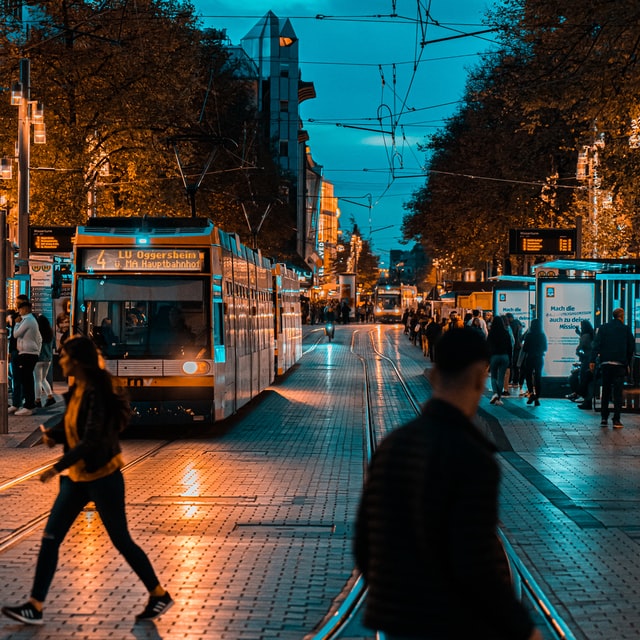Co-producing quality places: citizens, systems and outcomes

This blog series looks at lessons learned from a trip to Mannheim, Germany, in early 2017. It sets out some of the observations and learning for Scotland. In this blog, we look at what we can learn from Mannheim regarding citizens, systems and outcomes. This relates to the Place Standard theme of identity and belonging.
Mannheim is an industrial city of about 300,000 people in the Baden Wurtenburg region of Germany, which is bisected by the Rhine and the Neckar rivers. Rebuilt after 1943, today’s Mannheim is architecturally functional and efficient. It is laid out on a strict grid: in the city centre, there are no street names, just numbers referencing the grid.
‘Real life’ is evident all around
Though Mannheim is a university city, it feels very different to the strongholds like Heidelberg or St. Andrews. Young people who have experienced the different forms of university city say you encounter more real citizens and real-life situations in Mannheim.
Situated between a tram hub, a church and a school, Neckar Urban Gardens is a loose collection of gardening plots created by a community of activists on city-owned land. The have created a membership model that manages costs down to the minimum, to pay the ground rent and the water. Everything else is borrowed, found in skips or spare equipment. The garden community is comprised of students, families, refugees and local office workers.
Some of the alcoholics who pass their time in the platz near the gardens have plots which they tend to with interest and discipline. Sometimes, they drink too much and argue. Sometimes, the families with children get scared. Sometimes the police are called. But, ultimately, the garden is making a difference by providing a space that brings people together.
What influences the city?
With a history of migration, hosting refugees and engaging with the differences in its population are part of how Mannheim works. Its diversity is shaping the way it plans its outcomes and strategies for action.
Music is the pulse of the city. A venue for rock bands, but also an incubator for the business of the music business, the city hosts the Pop University; was the home of Mozart; and influenced a genre of classical music development, the Mannheim school. A US military presence influenced the buoyant blues and jazz scene in the city. And this leads us nicely on the reason we’re here.
The area we are particularly interested in: Franklin Barracks
Mannheim has over 500ha of former US Military barracks that it is looking to regenerate to build new forms of city districts, with co-production at the heart.
Franklin Barracks is being redeveloped as a new neighbourhood of the city. Some of the military family housing has been demolished, with some of the material being reused; garden spaces are being opened up; some old housing is being converted for modern needs; and extra floors, and in some cases balconies and external stairways, are being built on existing structures. Energy performance is being improved. Internal spaces are being reconfigured to support a variety of family living choices.
Some of the housing was even quickly adapted to temporarily accommodate the influx of refugees, reflecting Mannheim’s migration tradition.
How is the regeneration managed and what does Mannheim aim to achieve?
The public-sector Development Company is staffed by enthusiastic young women who speak with clarity, confidence and conviction about the process of ‘conversion’. (Leading to some reflection about how we could make our public sector a place where young people choose to develop their career.)
But at a city management level, Mannheim is also interesting. The Mayor, Dr Kurz, has committed to an outcomes framework, where all of the public sector is aligned in their intent, actions and resourcing to improving agreed outcomes in the city. This vision is underpinned by a commitment to engaging citizens and multiple opportunities for participation. The clear intent is to move from a model of citizen as consumer to citizen as participant.
Governance
This governance clarity around intent is reflected in the process being adopted at the Franklin Barracks. Engaging the city, surrounding citizens and future citizens is a key priority in ensuring a future engaged community who shares the conversation on priorities and action with the wider city governance. The approach breaks down into specific areas of focus: Empowering, Experimenting, Obligating and Educating.
The Mayor met with people in the neighbourhood and in city café spaces to discuss and experiment with the possibilities, and this produced ‘1000 ideas’ which informed outcomes and ambitions listed in ‘The White Book’, a tool to negotiate stakeholder interests, cross-party political interests and a longitudinal commitment to the investment.
Community benefit
Experimental spaces, programmes and activities to invite citizens, artists and groups to use space to test possibilities, to build new allegiance with a new community are facilitated by the Development Company. The outcomes of all this engagement help inform community benefit requirements of the development, as well as how the benefits are evaluated.
The ambition of the ‘conversation’ stage of the regeneration is to build the participatory and governance structures at community and city level at the same time as the physical development.
There seems to be as much focus on the social masterplan as the physical.
Lessons on co-producing quality places
Explore the rest of our blog series on co-producing quality places. It sets out some of the observations and learning for Scotland from a 2017 trip to Mannheim in Germany.
